
Meet the developers combining Power Platform and Azure to go faster
Software developers around the world are embracing low-code as a powerful part of their toolkit — they look at Microsoft Power Platform as the next layer of abstraction that reduces repeated work, adds to their skill set, and lets them focus their coding energy on the problems that matter most. The increased level of productivity is also changing the way these developers work with their users — as fusion teams creating a much more active and rewarding environment for building impactful solutions faster than ever before.
Let’s meet a few of these developers and look at solutions built using Power Platform along with Azure services.
Quick links: Meet the developers | Meet the organizations | Architecture Examples | Get Involved
Meet the developers
Featured developer: Gini Brandon
Gini Brandon is a Power Platform developer at Nuclear Promise X. “I didn’t really plan to go into or stay with Power Platform when I started,” was her initial sentiment when introduced to low-code. As she learned more and built impactful solutions, she eventually fell in love with what Power Platform enables for everyone, including professional developers like herself. In this video, Gini talks about her journey graduating with a computer science degree, how she’s been able to increase efficiency using Power Platform, why she believes low code is the future of development, and how you can get started.
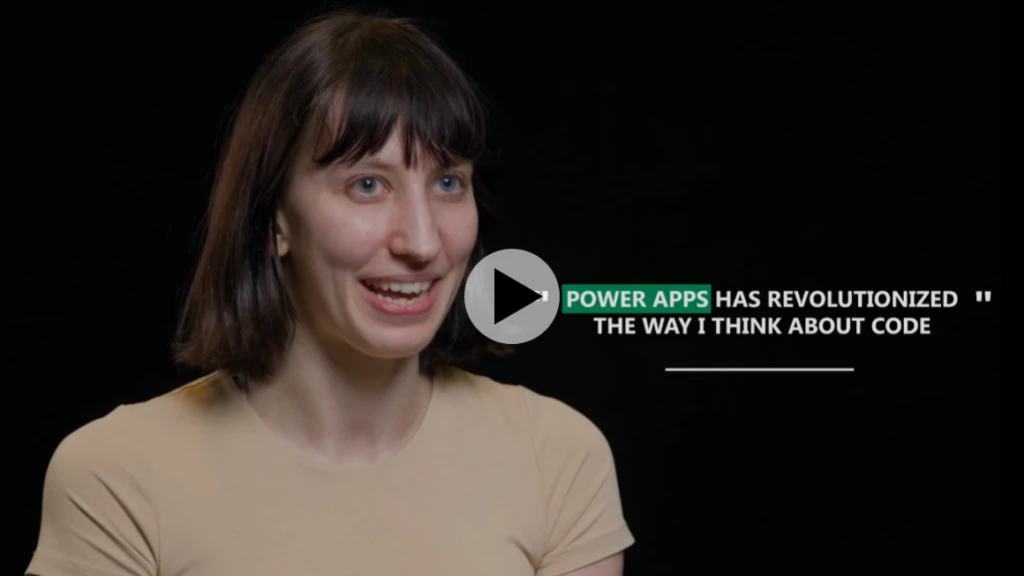
There are thousands of developers like Gini who have used Microsoft Power Platform in conjunction with code-first development tools and services to build enterprise grade digital solutions. Let’s meet a few of them and get a deep look into some of the solutions.
Meet the organizations
Organizations around the globe have adopted Microsoft Power Platform along with Azure and Dynamics 365 to build flagship applications and establish centers of excellence to scale adoption and impact of low-code solutions.
 |
Blackmores
A team of full stack developers used Dynamics 365 and Power Platform, along with Microsoft Dataverse, to consolidate and unify several systems. Includes apps for coaching sales staff, managing vendors, and more. |
 |
City of Ottawa
City of Ottawa IT used a fusion development approach to deploy an external facing chatbot for citizens and an internal chatbot for employees. The chatbot built using Power Virtual Agents uses Power Automate and custom code to integrate with multiple internal and external systems. |
 |
Coca-Cola Bottling Company United
Power Automate desktop flows were used to automate complex back-end processes for managing vending machines cartridge replacements. |
 |
Ecolab
Ecolab leveraged Power Platform integrated with Dynamics 365, Azure, and Microsoft 365 to build “The Hub” – a unified app for managing core sales and service processes. |
 |
EY
Complex digital solutions built by code-first professional developers working in fusion teams. They use Power Platform (including Dataverse) along with Azure and integrate with several third-party services. Scenarios include – processing emergency loans for small businesses, managing global employee mobility, transforming an annual salary review process, helping executives manage quality and risks, and more
|
 |
FortisAlberta FortisAlberta won a Canadian Safety Technology Award for this Microsoft Power Platform solution. To more efficiently document Injury Prevention Plans (IPPs), they transitioned away from paper forms to using Power Apps and Power BI. Solution built by Fidelity Factory. customer story |
 |
G&J Pepsi
G&J Pepsi has digitally transformed their organization with Power Apps, Power Automate and Power BI, equipping nearly 900 field personnel with mobile apps that have saved the organization over $1.5 million. |
 |
IKEA Sweden
Power Apps apps are used to manage in-store kitchen sales appointments, B2B sales pipeline, and speed up customer support requests. Built by Microsoft Gold Partner Capgemini. |
 |
NSure
Nsure.com is a proprietary online insurance shopping platform that enables consumers to transparently compare home and auto insurance quotes from more than 50 top-rated insurers and purchase a policy within minutes. A back-end system driven by Power Platform, Dynamics 365, and Azure services automates much of the process. The automation has resulted in over 50% of their customers completing their insurance purchasing without having to speak to an agent. |
 |
Rabobank
blog post | customer story | customer story – Power Virtual AgentsRabobank is the second-largest bank in the Netherlands, with more than 40,000 employees in 38 countries. As part of a broad digitization strategy, Rabobank adopted Power Platform to streamline internal processes and today runs more than 2,500 Power Apps and Power Automate solutions, built in partnership between code-first and citizen developers. Over 55% of the entire organization uses Power Platform solutions. As one example, a “Reorganization App” built to assist HR and managers has reduced an analysis that used to take three weeks down to three minutes. |
 |
Toyota
Toyota has established a center of excellence to enable makers across the organization to build solutions. They’ve extended Power Apps development with Microsoft Azure Cognitive Services and Azure Machine Learning to create an accessory installation app that uses computer vision to look at vehicles and determine whether they are equipped with the appropriate equipment and whether that equipment is in the desired condition. |
 |
Western States Caterpillar
customer story | MBAS presentationWestern States Caterpillar Equipment Company is an authorized Caterpillar dealer with seventeen branches in the United States. Pro-developers in the IT team built mobile Power Apps solutions in collaboration with business teams. The apps connect with multiple internal and external systems and are used to manage equipment rentals, sales activities, and more. As a result, rental returns across their $140M fleet of equipment can now be processed and equipment made ready to rent again within a single day. |
Solution Architecture Examples
These are a few real-world solution architecture examples that show how low-code capabilities in Power Platform are used in conjunction with code-first programming patterns and capabilities in Microsoft Azure.
Rabobank – Scaling adoption across the organization
Rabobank is the second-largest bank in the Netherlands, with more than 40,000 employees in 38 countries. As part of a broad digitization strategy, Rabobank adopted Power Platform to streamline internal processes and today runs more than 2,500 Power Apps and Power Automate solutions. Power Platform was recently chosen as the default platform for all internal application and business process automation development.
They built a solution called R@app (Reorganization App) that uses Power Apps, Power Automate, Power BI, SharePoint, Bing Maps, Azure SQL, and Azure Data Factory. It integrates with Workday, the bank’s HR system, and leverages customized Python algorithms.
The solution was delivered right on schedule and performance was even better than expected. To quote the customer, “With our reorganization app (R@pp) built with Power Platform, analysis that used to take three weeks can now be done in three minutes. Better yet, we have achieved a placement accuracy of 99.1%, which is far higher than what we could manage previously.”
For more details: Read the Rabobank story

The business process flow for the bank’s reorganization app called R@pp.
EY – Loan forgiveness portal
When the COVID-19 pandemic hit the United States, the government passed the Coronavirus Aid, Relief, and Economic Security (CARES) Act, which included financial support for small businesses. This support was provided under the Paycheck Protection Program (PPP), and it included loans as well as forgiveness on qualified expenses. The scope was huge, and banks had to rapidly respond to manage tens of thousands of applications.
A team of professional developers in the Low Code Services area within the Client Technology division at EY turned to Microsoft Power Platform and Azure and were able to successfully stand up a solution within weeks as opposed to months. The solution that EY created consists primarily of two different applications: a borrower portal using Power Pages, and the lender application using a Power Apps model-driven app. Both interact with the same data that is stored within Dataverse. The solution works seamlessly with multiple third-party services using both prebuilt and custom connectors. This ability was one of the most important aspects of the solution. It’s what enabled the tool to cover the entire application process and submit a complete loan forgiveness application—something other competitors couldn’t match.
For more details: Read the EY-PPP customer story | Watch the EY-PPP presentation | Watch the EY-PPP video
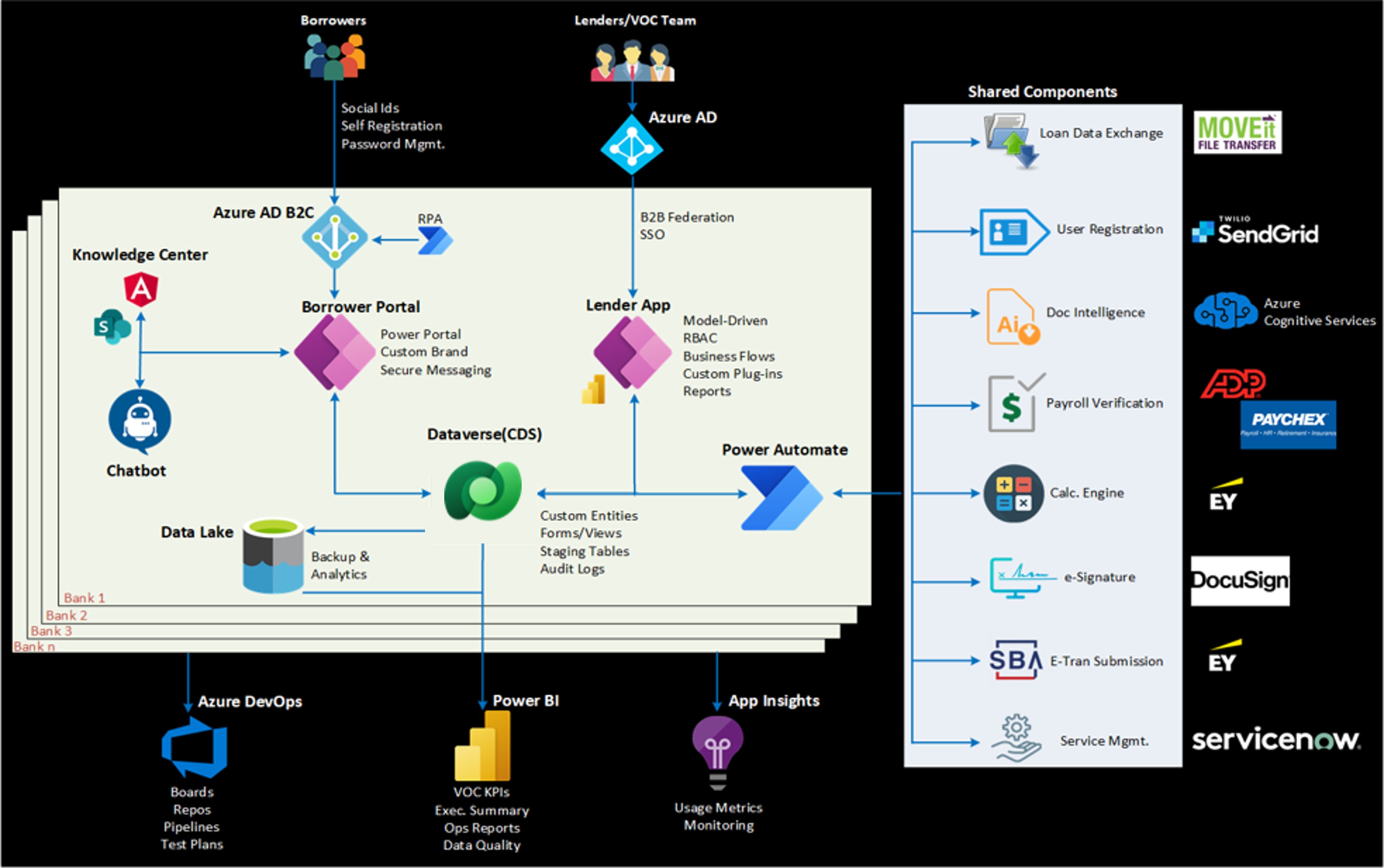
Diagram showing the complete solution architecture, including connectors to multiple services covering user authentication, data verification, and submission.
Blackmores Group – Enabling rapid development of new products
Blackmores Group is a highly regarded Australian health supplement maker. In a field where new product development plays a key role in maintaining market share, time is critical. Blackmores wanted to uncover the insights it needed to hasten product development and costly off-the-shelf options didn’t quite fit the company’s requirements.
The fusion development team at Blackmores designed “Project Lucky” as a central platform that brings together data scattered among 10 siloed business systems. It uses Dataverse as the data repository and incorporates a broad spectrum of Azure services, including Azure Functions to easily connect data sources for easier processing and faster reaction to events. The team uses Azure Data Lake Storage to scale and secure its data lake with encryption at rest and for advanced threat protection. With the Application Insights feature in Azure Monitor, the team gains a rich outlook across applications that accelerates proactive remediation. Blackmores relies on Azure Event Hubs, a fully managed, real-time data ingestion service. A future version will incorporate Azure Machine Learning and other AI capabilities in Azure.
“Our team treats Power Apps and Azure as one platform that we use to build our solutions… Our ability to extend Microsoft Power Platform with Azure gives us the confidence to use it for complex projects like Project Lucky.”
– Tijn Tacke, Head of Business Applications, Blackmores Group
For more details: Read the Blackmores customer story | Watch the Blackmores presentation
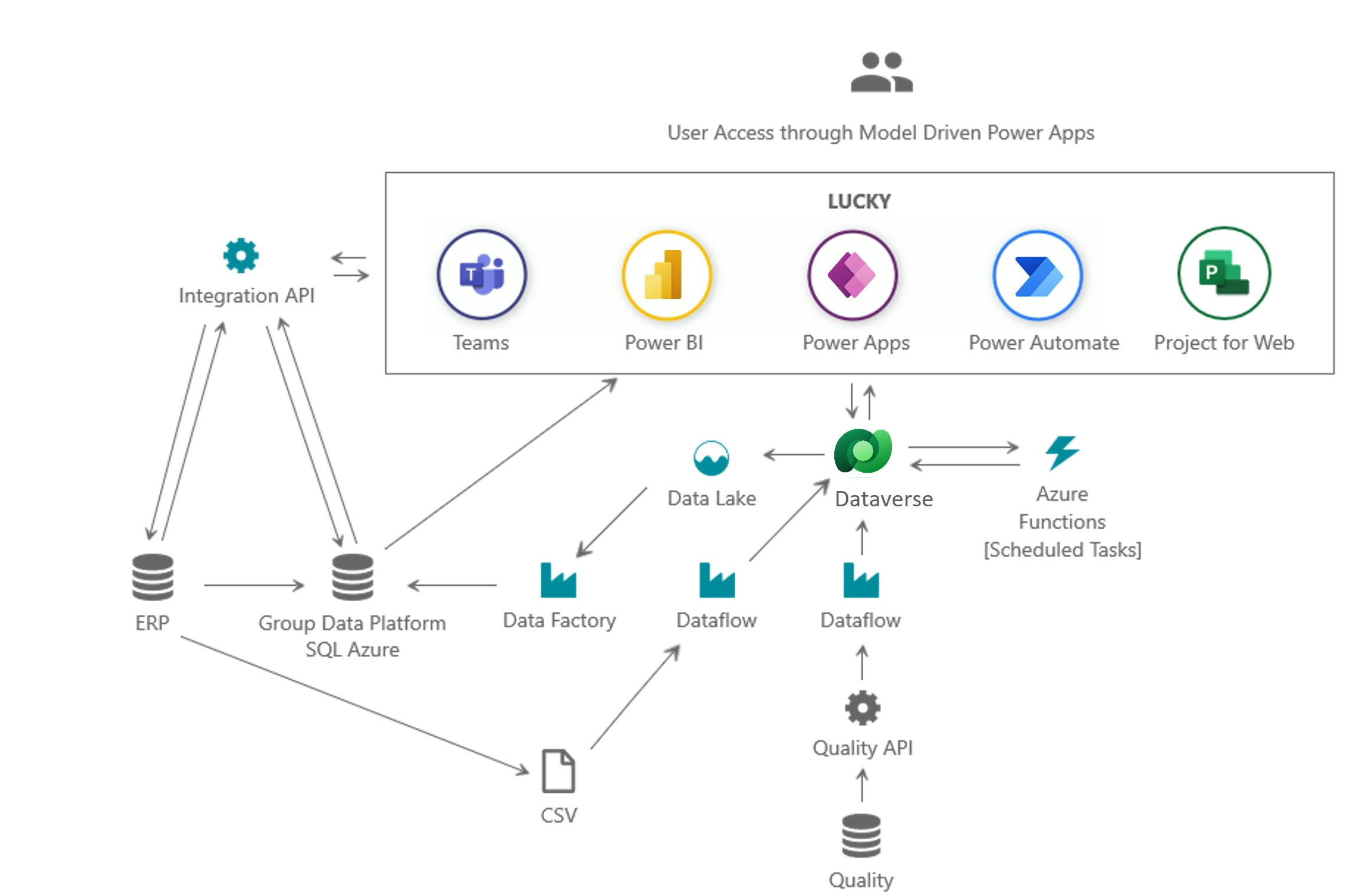
Solution architecture diagram for Project Lucky
IKEA Sweden – Reimagining the customer experience
IKEA Sweden partnered with Capgemini, a Microsoft Gold Partner, to build a Dynamics 365 and Power Platform solution for its sales staff to improve the kitchen buying experience for individual customers (B2C) and businesses (B2B). This project enabled tracking of the sales process from the first meeting with the customer to the installation of the kitchen and contributed toward IKEA realizing the vision of having a holistic single view of the customer over the lifetime of their relationship.
The solution architecture includes Dynamics 365 Sales and Power Apps model-driven apps as the front-end experience. Dynamics 365 Field Service is used for scheduling and distributing appointments. Power Automate is used for automatic updates of status fields and sending notifications. All data is stored in Dataverse. Azure Logic Apps is used to email customer meeting summary notes and quotes. Azure functions are used for complex and time-consuming custom business logic. Azure blob storage is used for secure storage of information. Azure Key Vault is used for managing credentials and storing access and security related data in the cloud.
For more details: Read the IKEA Sweden technical case study on the Power Apps blog
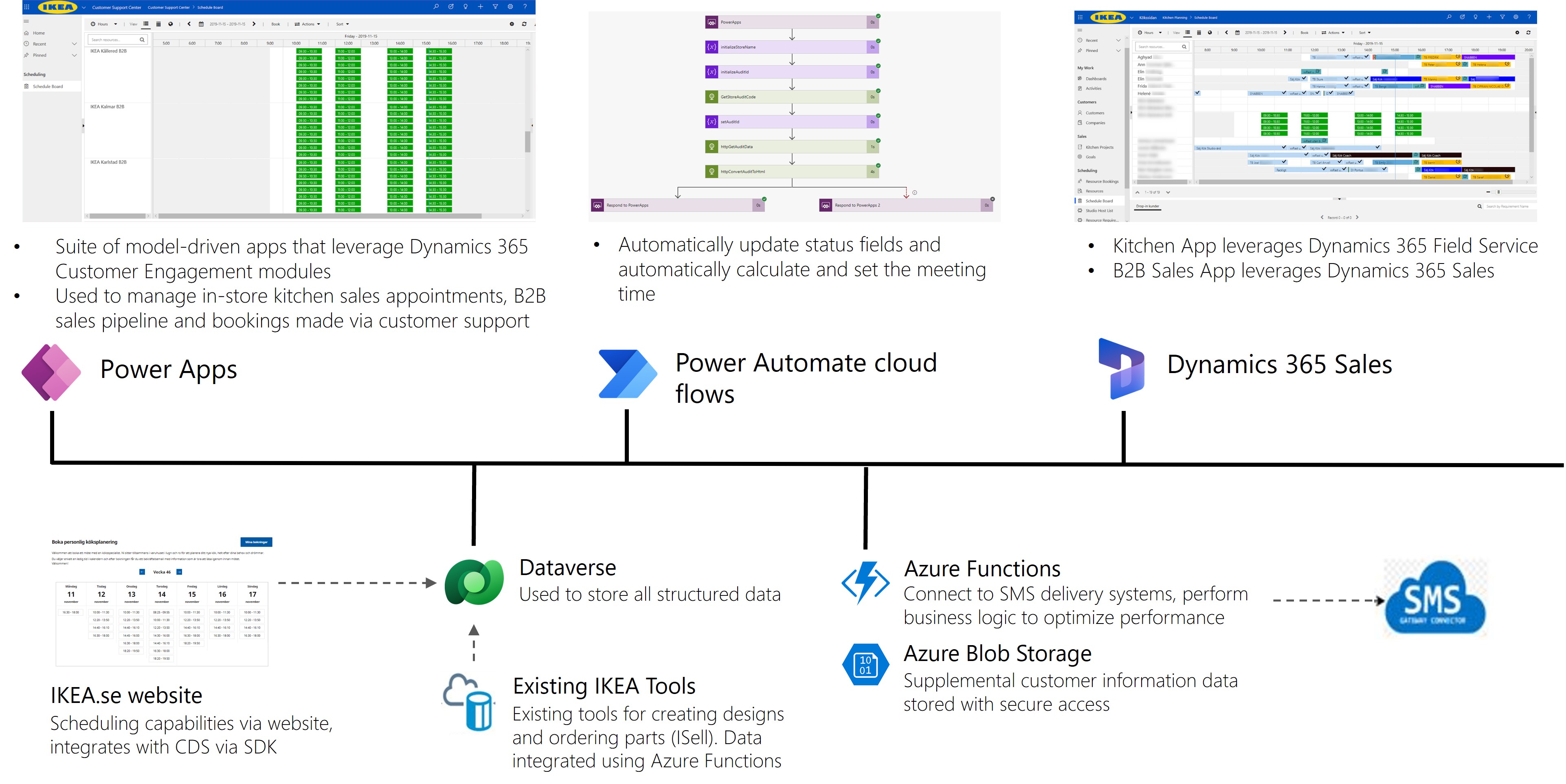
Solution architecture diagram for the IKEA Kitchen Tool solution
Western States Caterpillar: Mobile apps for the field
With a thriving rental business across several stores in the United States, Western States Caterpillar turned to Microsoft Power Platform to modernize and transform two critical business processes that were fundamental to their growth:
- Managing the rental return process in a way that reduced turnaround time – “Return to Ready” app
- Enabling sales teams in the field to better understand their prospects and customer spend – “Client Connect” app.
The Strategy & BI Solutions team followed a ‘low-code plus code-first’ development pattern for both their Return to Ready and Client Connect apps. Both apps read equipment and customer spend data from a SQL Server database which is a replication of their Microsoft Dynamics AX 2012 ERP data. The retrieve and write of data and events are performed through a Power Platform custom connector which interacts with custom web APIs developed in ASP .NET Core. The two apps have been developed with Power Apps. All pictures taken from the Return to Ready app is handled by an Azure hosted web API that leverages Azure Blob storage. The AI Builder Business Card scanner is used by the Client Connect app to create prospects and contacts easily across all their stores. All information of their rentals and sales created and updated in the apps are surfaced into Power BI reports.
For more details: Read the Western States Caterpillar technical case study on the Power Apps blog
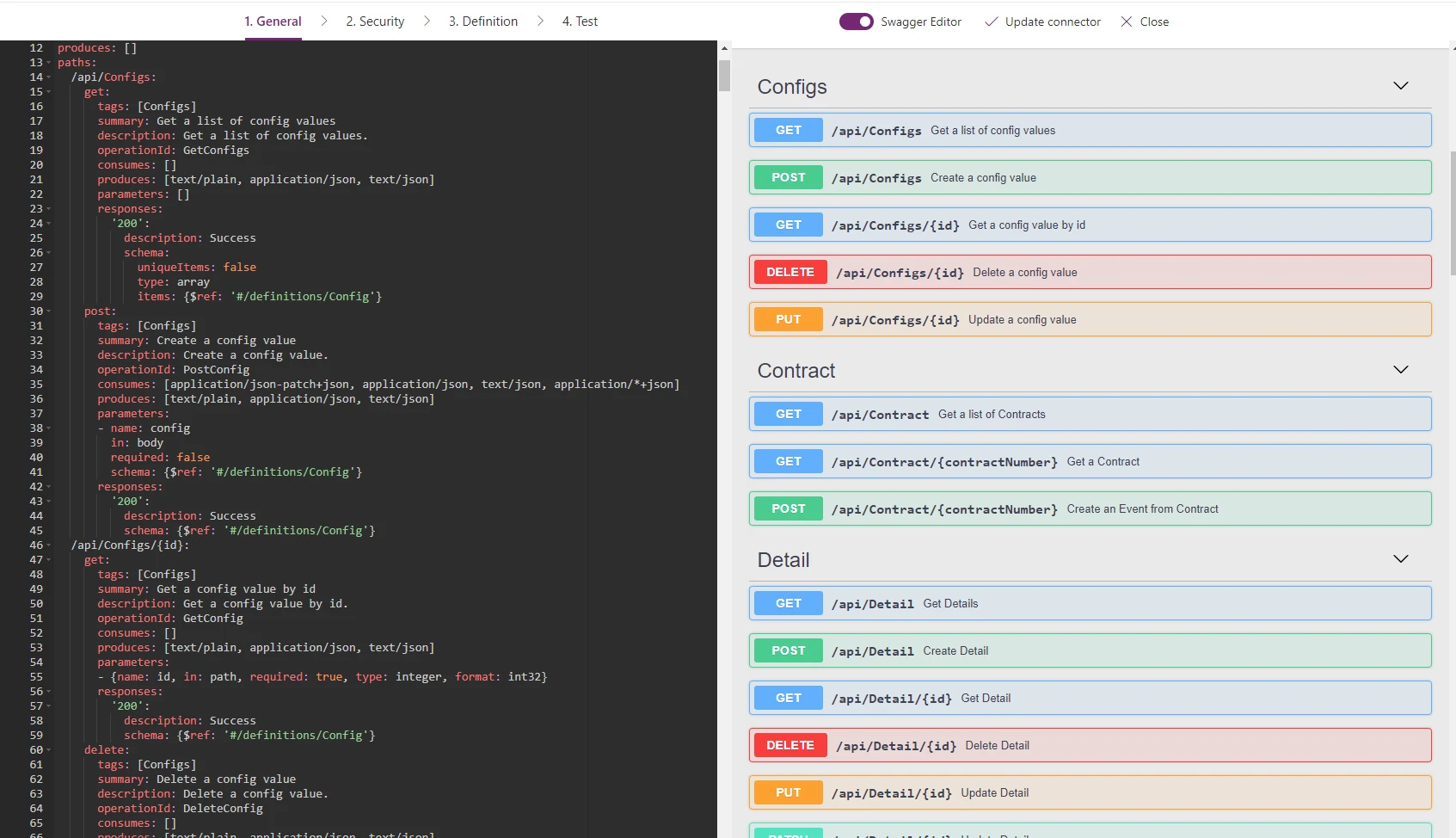
Screenshot of swagger definition file for the custom connector
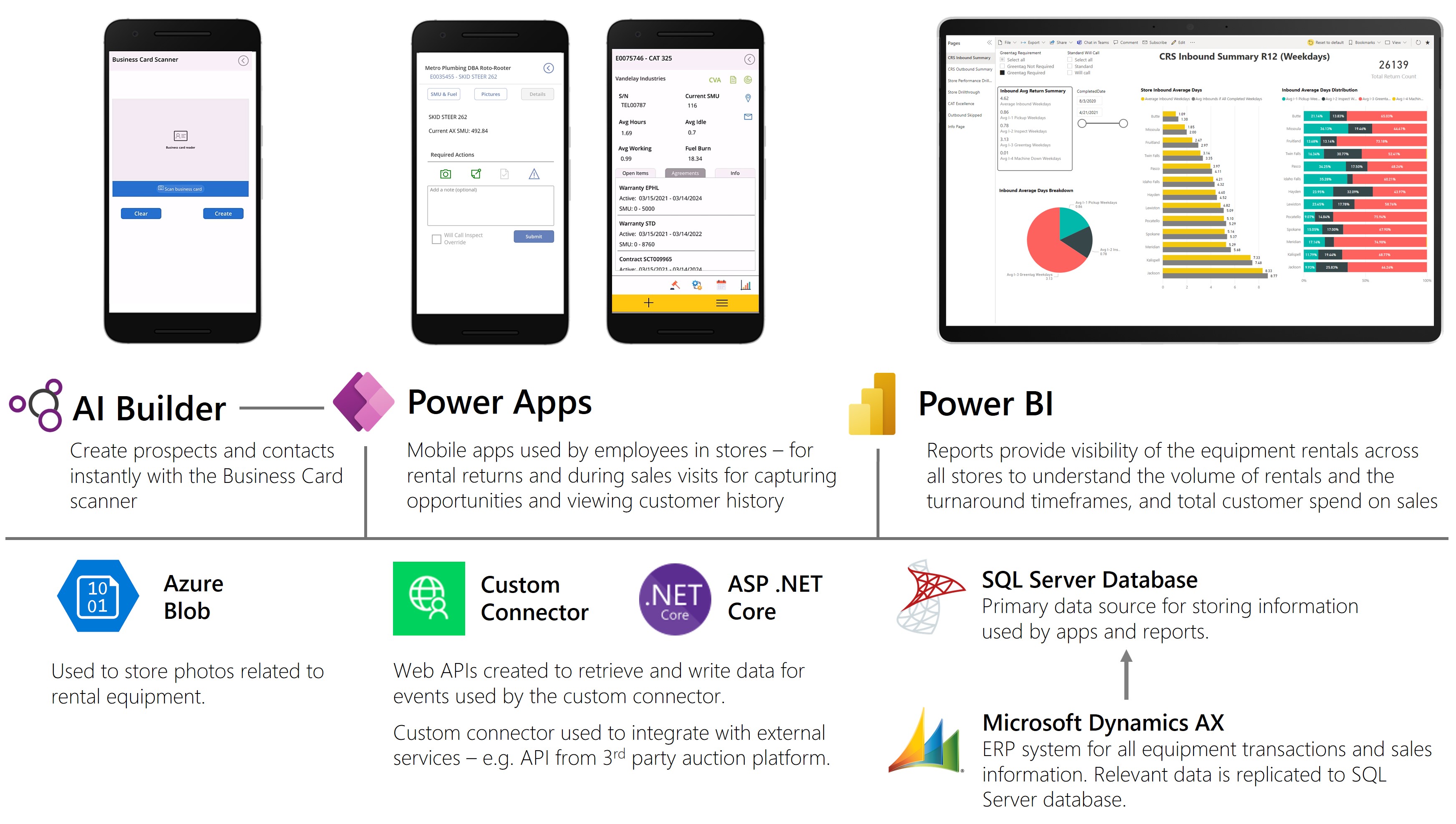
High level solution architecture that combines low-code and code-first development patterns
Get involved
- Sign up for the free Power Apps Developer Plan.
- Enroll in the Cloud Skills Challenge to learn more about low code and fusion team fundamentals and start climbing that leaderboard!
- Save the #LowCode February page to start your learning on Feb 1, and Subscribe to the blog in your favorite feed reader for updates.
Resources
- Microsoft Power Platform is the best way for teams to build together – blog post with resources
- Pro-dev features and learning paths – E-book | learning path | Build conference session | webinar
- Power Apps developer plan – get started | documentation
- Microsoft Mechanics episode on pro-dev adoption of Power Platform – blog | video
- Low code application development on Azure – landing page | YouTube video playlist | tours
- Power Apps and Microsoft Azure better together – landing page | TEI report | ROI calculator
- POWERful Devs virtual conference and ongoing videos – video series
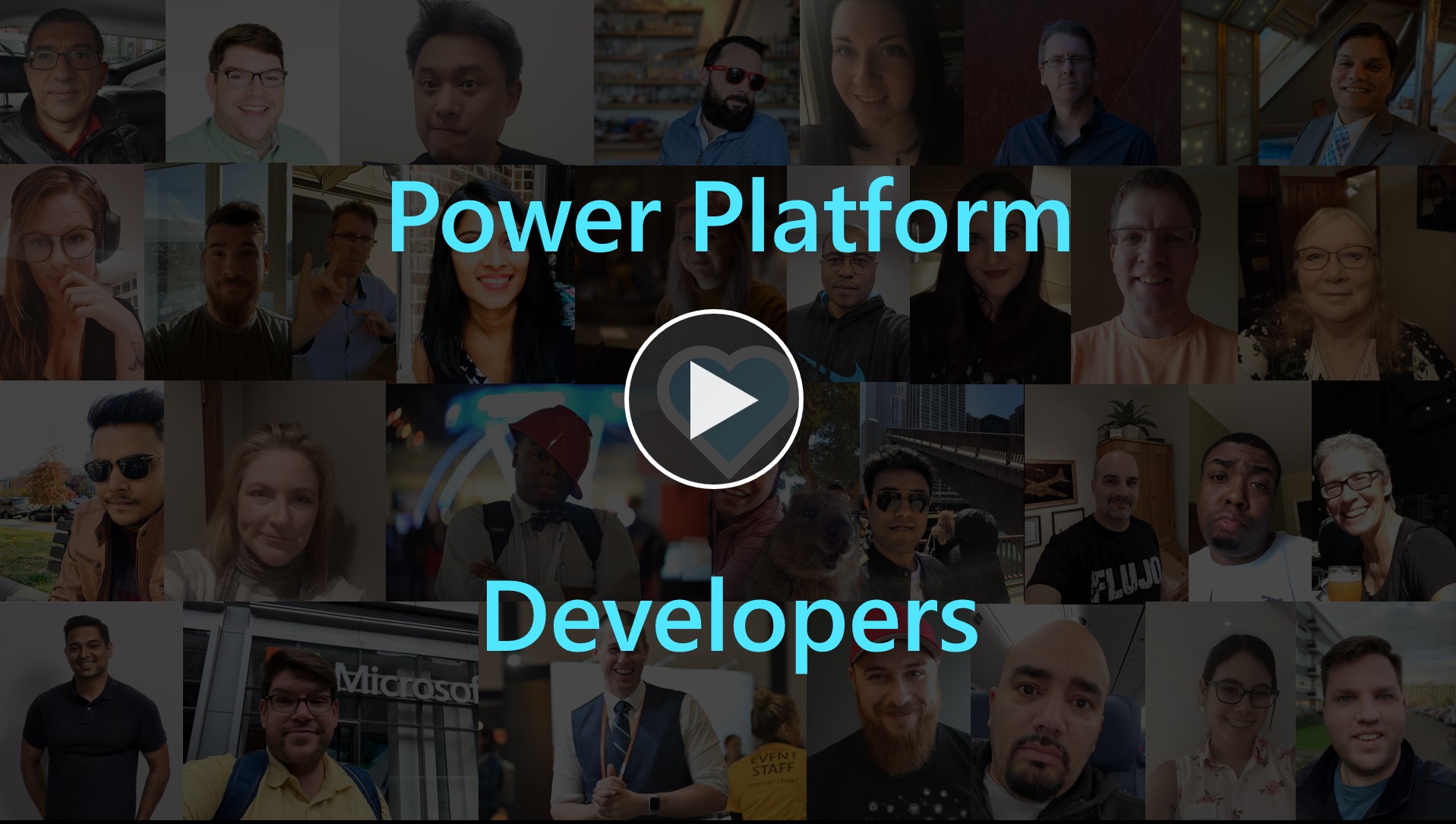
Watch developers from around world share their perspective on adopting Power Platform to go faster
Related links
100+ Power Platform customer stories
70+ Power Platform customer story videos






